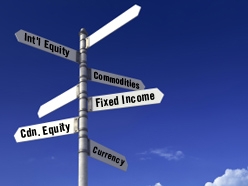
This past year has been a wild one for commodities — gold reached all time nominal highs, oil climbed from around $70 to almost $90, while natural gas bas barely budged from a low $4. Fortunately for investors, the outlook for 2011 is less volatile; commodity prices should be on their way up.
Oil
It’s taken crude oil about two years to near pre-recession levels, and unless there’s another crisis, it should say around $90. It’s a price Kevin Kelly, an associate portfolio manager at Mackenzie Financial, likes. “$80 to $90 oil is a great range for business in most places in the world,” he says.
Oil will stay in that range for a few reasons, says Kelly. First of all it’s a range that OPEC likes. “The language OPEC uses shows that they’re quite comfortable with oil prices between $75 and $95,” he says. “They need that price to support their internal budget and economies and they know the world can afford to pay it.”
There’s also increasing global demand for oil and that’s putting pressure on prices. Kelly says that in a couple of years excess supply will tighten thanks to demand from emerging markets. The amount of new supply, he says, isn’t keeping up with China’s rapidly rising oil intake. Two years ago there was 5 million barrels of excess capacity a day, that’s expected to drop to about 1 million barrels a day, which will push prices higher.
John Kurgan, a senior market strategist with Toronto-based Lind Waldock, says increasing demand may even send prices above $100 a barrel. “We’re already at about $90, and another $10 really isn’t that much,” he says.
Natural Gas
Natural gas has the most room to run, says Kelly, as the price is so low that he can easily envision a 50% jump. Historically, natural gas and oil prices moved more or less in tandem with a 8:1 price difference. Today it’s 22:1.
While the prices likely won’t fall in line soon, Kelly expects it to happen at some point. North American companies are starting to export natural gas to markets where the commodity is more tied into crude prices.
“Companies are developing liquefied natural gas and shipping it to Asia,” he says. Some overseas markets pay $10 or $15 per 1,000 cubic feet, versus the $4 price in North America. “It will take some time to figure out how to arbitrage oil and natural gas prices,” he says, “but we’re seeing gas get bid up all over the world.”
There is one problem facing natural gas: oversupply. New drilling technology has made it easier and cheaper to drill for natural gas and that could suppress prices. But, Michael Herring, an investment strategist with BMO Capital Markets says if prices get too low, drilling will stop and prices will rebound.
The business was hurt in October, when gas prices fell below $4, he says. “It was the exhaustion point for people who have been selling gas,” Herring explains. Since then the price has climbed by about 10%. “It’s a reflection that once you get below $4 even shale becomes a lot less profitable,” he says.
Herring predicts gas prices to stay in the $5 to $6 dollar range next year. “Under where it is now things start to shut down. Over $5 and activity will increase.”
Gold
When a gold-dispensing vending machine ends up in a Florida mall, you should probably start second-guessing whether or not it should be added to a portfolio. Prices have climbed about 27% since the start of 2010 and broke the $1,400 barrier in November. For many, that price is too good to be true.
Most commodities rise and fall on supply and demand, but not gold. The price has been jacked up purely on sentiment — people think the U.S. dollar will fall and the economy will continue to suffer, so they’re flocking to the precious metal for safety.
According to the World Gold Council, excess production hit about 1,930 tonnes this year, proving supply and demand are out of synch. But that doesn’t mean gold prices won’t continue to rise.
“Everything has been shaping up for the price to go higher,” says Kurgan. China continues to import copious amounts of gold — about five times more than 2009 — while central banks continue to stockpile it. “It’s the 10th annual price increase,” he says. “That’s the longest winning streak for gold since the 1920s.”
Kelly only holds about 10% of his portfolio in gold as a hedge against inflation. He says he could see it hit $1,500, especially if the U.S. government continues its quantitative easing measures, but it could just as easily fall too. If people start feeling more bullish on the economy, they may turn away from gold. “You could see people trading out of it,” says Kelly. “They’ll no longer need it as a store for value as they rotate back into other commodities or equities.”
When that happens gold prices could stay low for years — gold fell from $850 to $300 between 1980 and 1982 and save for a few minor upswings, it hovered around $300 and $400 for 15 years. Still, many expect gold prices to move at least $200 higher before it settles down.
In general, the outlook for most commodities is positive. Kurgan thinks silver prices will rise, while cotton futures are at an all-time high this year. Even sugar prices will climb — it’s already risen 45% since Labour Day.
It’s a rebounding economy that’s driving up most commodities, he says. “When things start to pick up there will be a huge demand for commodities and supply just won’t be there,” he says. “How it will all play out is anyone’s guess, but I think we’ll see a number of markets advance considerably.”